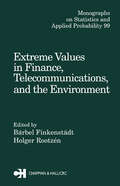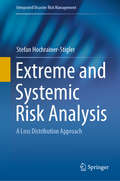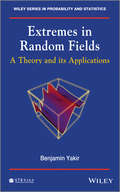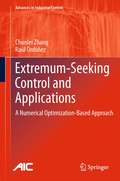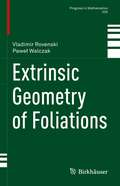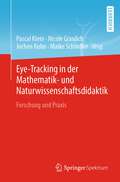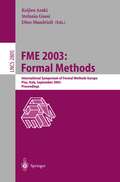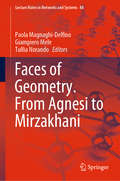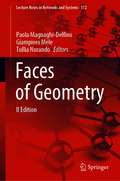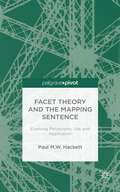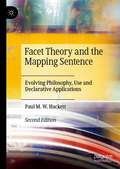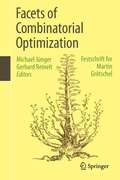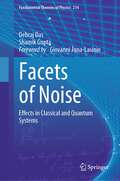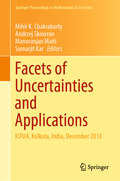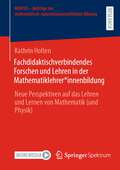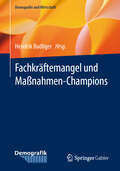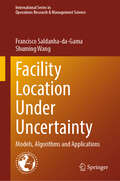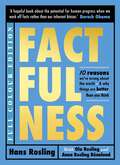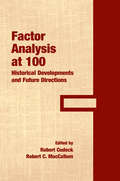- Table View
- List View
Extreme Values in Finance, Telecommunications, and the Environment (Chapman & Hall/CRC Monographs on Statistics and Applied Probability)
by Bärbel Finkenstädt Holger RootzénBecause of its potential to ...predict the unpredictable,... extreme value theory (EVT) and methodology is currently receiving a great deal of attention from statistical and mathematical researchers. This book brings together world-recognized authorities in their respective fields to provide expository chapters on the applications, use, and theory
Extreme and Systemic Risk Analysis: A Loss Distribution Approach (Integrated Disaster Risk Management)
by Stefan Hochrainer-StiglerThis book is about how extreme and systemic risk can be analyzed in an integrated way. Risk analysis is understood to include measurement, assessment as well as management aspects. Integration is understood as being able to perform risk analysis for extreme and systemic events simultaneously. The presented approach is based on Sklar's theorem, which states that a multivariate distribution can be separated into two parts – one describing the marginal distributions and the other describing the dependency between the distributions using a so-called copula. It is suggested to reinterpret Sklar's theorem from a system or network perspective, treating copulas as a network property and individual, including extreme, risk as elements within the network. In that way, extreme and systemic risk can be analyzed independently as well as jointly across several scales. The book is intended for a large audience, and all techniques presented are guided with examples and applications with a special focus on natural disaster events. Furthermore, an extensive literature and discussion of it are given in each chapter for the interested reader.
Extreme physics
by Jeff Colvin Jon LarsenMost matter in the Universe, from the deep interior of planets to the core of stars, is at high temperature or high pressure compared to the matter of our ordinary experience. This book offers a comprehensive introduction to the basic physical theory on matter at such extreme conditions and the mathematical modeling techniques involved in numerical simulations of its properties and behavior. Focusing on computational modeling, the book discusses topics such as the basic properties of dense plasmas; ionization physics; the physical mechanisms by which laser light is absorbed in matter; radiation transport in matter; the basics of hydrodynamics and shock-wave formation and propagation; and numerical simulation of radiation-hydrodynamics phenomenology. End-of-chapter exercises allow the reader to test their understanding of the material and introduce additional physics, making this an invaluable resource for researchers and graduate students in this broad and interdisciplinary area of physics.
Extremes and Recurrence in Dynamical Systems
by Valerio Lucarini Ana De Freitas Jorge De Freitas Davide Faranda Mark Holland Matthew Nicol Mike Todd Sandro Vaienti Jeroen WoutersPresents recent advances on the theory of extreme values that result from investigations of dynamical systems applications Written by a team of international experts, Extremes and Recurrence in Dynamical Systems presents a unique point of view on the mathematical theory of extremes and how it relates to applications in the natural and social sciences. Featuring an interdisciplinary approach to new concepts in pure and applied mathematical research, the book skillfully combines the areas of statistical mechanics, probability theory, measure theory, dynamical systems, statistical inference, geophysics, and software application. Emphasizing statistical mechanics, the book introduces robust theoretical embedding for the application of extreme value theory and modeling through dynamical systems. Extremes and Recurrence in Dynamical Systems also features: A careful examination of how a dynamical system can be taken as a generator of stochastic processes Discussions on the applications of statistical inference in the theoretical and heuristic use of extremes Several examples of analysis of extremes in a physical and geophysical context A final summary of the main results presented with a discussion of forthcoming research guidelines An appendix with software Matlab® and Octave programming language to help readers to develop further understanding of the presented concepts Extremes and Recurrence in Dynamical Systems is ideal for academics and practitioners in pure and applied mathematics, probability theory, statistics, chaos, theoretical and applied dynamical systems, statistical mechanics, geophysical fluid dynamics, geosciences and complexity science.
Extremes in Random Fields: A Theory and Its Applications (Wiley Series in Probability and Statistics #265)
by Benjamin YakirPresents a useful new technique for analyzing the extreme-value behaviour of random fields Modern science typically involves the analysis of increasingly complex data. The extreme values that emerge in the statistical analysis of complex data are often of particular interest. This book focuses on the analytical approximations of the statistical significance of extreme values. Several relatively complex applications of the technique to problems that emerge in practical situations are presented. All the examples are difficult to analyze using classical methods, and as a result, the author presents a novel technique, designed to be more accessible to the user. Extreme value analysis is widely applied in areas such as operational research, bioinformatics, computer science, finance and many other disciplines. This book will be useful for scientists, engineers and advanced graduate students who need to develop their own statistical tools for the analysis of their data. Whilst this book may not provide the reader with the specific answer it will inspire them to rethink their problem in the context of random fields, apply the method, and produce a solution.
Extremes in a Changing Climate
by Amir Aghakouchak David Easterling Kuolin Hsu Siegfried Schubert Soroosh SorooshianThis book provides a collection of the state-of-the-art methodologies and approaches suggested for detecting extremes, trend analysis, accounting for nonstationarities, and uncertainties associated with extreme value analysis in a changing climate. This volume is designed so that it can be used as the primary reference on the available methodologies for analysis of climate extremes. Furthermore, the book addresses current hydrometeorologic global data sets and their applications for global scale analysis of extremes. While the main objective is to deliver recent theoretical concepts, several case studies on extreme climate conditions are provided. Audience The book is suitable for teaching in graduate courses in the disciplines of Civil and Environmental Engineering, Earth System Science, Meteorology and Atmospheric Sciences.
Extremum-Seeking Control and Applications
by Chunlei Zhang Raúl OrdóñezExtremum-seeking control tracks a varying maximum or minimum in a performance function such as output or cost. It attempts to determine the optimal performance of a control system as it operates, thereby reducing downtime and the need for system analysis. Extremum-seeking Control and Applications is divided into two parts. In the first, the authors review existing analog-optimization-based extremum-seeking control including gradient-, perturbation- and sliding-mode-based control designs. They then propose a novel numerical-optimization-based extremum-seeking control based on optimization algorithms and state regulation. This control design is developed for simple linear time-invariant systems and then extended for a class of feedback linearizable nonlinear systems. The two main optimization algorithms - line search and trust region methods - are analyzed for robustness. Finite-time and asymptotic state regulators are put forward for linear and nonlinear systems respectively. Further design flexibility is achieved using the robustness results of the optimization algorithms and the asymptotic state regulator by which existing nonlinear adaptive control techniques can be introduced for robust design. The approach used is easier to implement and tends to be more robust than those that use perturbation-based extremum-seeking control. The second part of the book deals with a variety of applications of extremum-seeking control: a comparative study of extremum-seeking control schemes in antilock braking system design; source seeking, formation control, collision and obstacle avoidance for groups of autonomous agents; mobile radar networks; and impedance matching. MATLAB®/Simulink® code which can be downloaded from www.springer.com/ISBN helps readers to reproduce the results presented in the text and gives them a head start for implementing the algorithms in their own applications. Extremum-seeking Control and Applications will interest academics and graduate students working in control, and industrial practitioners from a variety of backgrounds: systems, automotive, aerospace, communications, semiconductor and chemical engineering.
Extrinsic Geometry of Foliations (Progress in Mathematics #339)
by Vladimir Rovenski Paweł WalczakThis book is devoted to geometric problems of foliation theory, in particular those related to extrinsic geometry, modern branch of Riemannian Geometry. The concept of mixed curvature is central to the discussion, and a version of the deep problem of the Ricci curvature for the case of mixed curvature of foliations is examined. The book is divided into five chapters that deal with integral and variation formulas and curvature and dynamics of foliations. Different approaches and methods (local and global, regular and singular) in solving the problems are described using integral and variation formulas, extrinsic geometric flows, generalizations of the Ricci and scalar curvatures, pseudo-Riemannian and metric-affine geometries, and 'computable' Finsler metrics.The book presents the state of the art in geometric and analytical theory of foliations as a continuation of the authors' life-long work in extrinsic geometry. It is designed for newcomers to the field as well as experienced geometers working in Riemannian geometry, foliation theory, differential topology, and a wide range of researchers in differential equations and their applications. It may also be a useful supplement to postgraduate level work and can inspire new interesting topics to explore.
Eye-Tracking in der Mathematik- und Naturwissenschaftsdidaktik: Forschung und Praxis
by Pascal Klein Jochen Kuhn Maike Schindler Nicole GraulichDieses Buch beschäftigt sich mit aktuellen Studien und Anwendungsmöglichkeiten von Eye-Tracking in der Mathematik- oder Naturwissenschaftsdidaktik: Was betrachten Lernende, wenn sie einen naturwissenschaftlichen Text lesen, mathematische Muster erkunden oder mit einem Diagramm arbeiten? Wie fokussieren und verteilen sie ihre Aufmerksamkeit beim Lösen mathematischer und naturwissenschaftlicher Aufgaben? Eye-Tracking liefert Antworten auf diese und weitere Fragen und kann somit dazu beitragen, Lernprozesse besser zu verstehen, Lernmaterialien und Lehrprozesse zu optimieren oder Unterschiede zwischen verschiedenen Expertisegruppen aufzudecken. Dieses Buch stellt aktuelle Studien aus der Mathematik- und Naturwissenschaftsdidaktik (Biologie, Chemie, Physik, Informatik) zusammen, die Eye-Tracking als zentrale Forschungsmethode zur Beantwortung von Fragestellungen entlang der Bildungskette (Primar- und Sekundarstufen sowie Universität) nutzen. Dabei wird deutlich, wie Eye-Tracking bereits etablierte Forschungsmethoden der empirisch forschenden Fachdidaktik, wie das Laute Denken, den Einsatz von Fragebögen oder Experteninterviews, ergänzt.Das Buch zeigt die vielfältigen Anwendungsmöglichkeiten von Eye-Tracking in der Mathematik- und Naturwissenschaftsdidaktik und enthält zahlreiche Best-Practice-Beispiele zum Design und zur Auswertung wissenschaftlicher Studien zum Thema. Das Buch richtet sich damit sowohl an Wissenschaftlerinnen und Wissenschaftler mit unterschiedlicher Erfahrung im Bereich Eye-Tracking als auch an (zukünftige) Lehrkräfte und Dozierende, da aus den empirischen Befunden Handlungsempfehlungen für den Unterricht bzw. die Lehre gegeben werden.
FME 2003: Formal Methods
by Dion Mandrioli Stefania Gnesi Keijiro ArakiThis book constitutes the refereed proceedings of the International Symposium of Formal Methods Europe, FME 2003, held in Pisa, Italy in September 2003. The 44 revised full papers presented together with 5 invited papers were carefully reviewed and selected from 144 submissions. The papers are organized in topical sections on industrial issues, control systems and applications, communication system verfication, co-specification and compilers, composition, Java, object-orientation and modularity, model checking, parallel processes, program checking and testing, B method, and security.
FME 2003: International Symposium of Formal Methods Europe. Pisa Italy, September 8-14, 2003, Proceedings (Lecture Notes in Computer Science #2805)
by Stefania Gnesi Keijiro Araki Dino MandrioliThisvolumecontainstheproceedingsofFM2003,the12thInternationalFormal Methods Europe Symposium which was held in Pisa, Italy on September 8–14, 2003. Formal Methods Europe (FME, www. fmeurope. org) is an independent - sociation which aims to stimulate the use of and research on formal methods for system development. FME conferences began with a VDM Europe symposium in 1987. Since then, the meetings have grown and have been held about once - ery 18 months. Throughout the years the symposia have been notably successful in bringing together researchers, tool developers, vendors, and users, both from academia and from industry. Unlike previous symposia in the series, FM 2003 was not given a speci?c theme. Rather, its main goal could be synthesized as “widening the scope. ” Indeed, the organizers aimed at enlarging the audience and impact of the symposium along several directions. Dropping the su?x ‘E’ from the title of the conference re?ects the wish to welcome participation and contribution from every country; also,contributionsfromoutsidethetraditionalFormalMethodscommunitywere solicited. The recent innovation of including an Industrial Day as an important part of the symposium shows the strong commitment to involve industrial p- ple more and more within the Formal Methods community. Even the traditional and rather fuzzy borderline between “software engineering formal methods” and methods and formalisms exploited in di?erent ?elds of engineering was so- what challenged.
Faces of Geometry. From Agnesi to Mirzakhani (Lecture Notes in Networks and Systems #88)
by Paola Magnaghi-Delfino Giampiero Mele Tullia NorandoThe volume reports on interdisciplinary discussions and interactions between theoretical research and practical studies on geometric structures and their applications in architecture, the arts, design, education, engineering, and mathematics. These related fields of research can enrich each other and renew their mutual interest in these topics through networks of shared inspiration, and can ultimately enhance the quality of geometry and graphics education. Particular attention is dedicated to the contributions that women have made to the scientific community and especially mathematics. The book introduces engineers, architects and designers interested in computer applications, graphics and geometry to the latest advances in the field, with a particular focus on science, the arts and mathematics education.
Faces of Geometry: II Edition (Lecture Notes in Networks and Systems #172)
by Paola Magnaghi-Delfino Giampiero Mele Tullia NorandoThe volume reports on interdisciplinary discussions and interactions between theoretical research and practical studies on geometric structures and their applications in architecture, the arts, design, education, engineering, and mathematics. These related fields of research can enrich each other and renew their mutual interest in these topics through networks of shared inspiration, and can ultimately enhance the quality of geometry and graphics education. Particular attention is dedicated to the contributions that women have made to the scientific community and especially mathematics. The book introduces engineers, architects and designers interested in computer applications, graphics and geometry to the latest advances in the field, with a particular focus on science, the arts and mathematics education.
Facet Theory and the Mapping Sentence: Evolving Philosophy, Use and Application
by Paul M.W. HackettHow do we think about the worlds we live in? The formation of categories of events and objects seems to be a fundamental orientation procedure. Facet theory and its main tool, the mapping sentence, deal with categories of behavior and experience, their interrelationship, and their unification as our worldviews. In this book Hackett reviews philosophical writing along with neuroscientific research and information form other disciplines to provide a context for facet theory and the qualitative developments in this approach. With a variety of examples, the author proposes mapping sentences as a new way of understanding and defining complex behavior.
Facet Theory and the Mapping Sentence: Evolving Philosophy, Use and Declarative Applications
by Paul M.W. HackettThis book is the second edition of Facet Theory and the Mapping Sentence: Evolving Philosophy, Use and Application (2014). It consolidates the qualitative and quantitative research positions of facet theory and delves deeper into their qualitative application in psychology, social and the behavioural sciences and in the humanities. In their traditional quantitative guise, facet theory and its mapping sentence incorporate multi-dimensional statistics. They are also a way of thinking systematically and thoroughly about the world. The book is particularly concerned with the development of the declarative mapping sentence as a tool and an approach to qualitative research. The evolution of the facet theory approach is presented along with many examples of its use in a wide variety of research domains. Since the first edition, the major advance in facet theory has been the formalization of the use of the declarative mapping sentence and this is given a prominent position in the new edition. The book will be compelling reading for students at all levels and for academics and research professionals from the humanities, social sciences and behavioural sciences.
Facets of Behaviormetrics: The 50th Anniversary of the Behaviormetric Society (Behaviormetrics: Quantitative Approaches to Human Behavior #4)
by Akinori Okada Kazuo Shigemasu Satoru Yokoyama Ryozo YoshinoThis edited book is the first one written in English that deals comprehensively with behavior metrics. The term “behaviormetrics” comprehends the research including all sorts of quantitative approaches to disclose human behavior. Researchers in behavior metrics have developed, extended, and improved methods such as multivariate statistical analysis, survey methods, cluster analysis, machine learning, multidimensional scaling, corresponding analysis or quantification theory, network analysis, clustering, factor analysis, test theory, and related factors. In the spirit of behavior metrics, researchers applied these methods to data obtained by surveys, experiments, or websites from a diverse range of fields. The purpose of this book is twofold. One is to represent studies that display how the basic elements of behavior metrics have developed into present-day behavior metrics. The other is to represent studies performed mainly by those who would like to pioneer new fields of behavior metrics and studies that display elements of future behavior metrics. These studies consist of various characteristics such as those dealing with theoretical or conceptual subjects, the algorithm, the model, the method, and the application to a wide variety of fields. This book helps readers to understand the present and future of behavior metrics.
Facets of Combinatorial Optimization: Festschrift for Martin Grötschel
by Michael Jünger Gerhard ReineltMartin Grötschel is one of the most influential mathematicians of our time. He has received numerous honors and holds a number of key positions in the international mathematical community. He celebrated his 65th birthday on September 10, 2013. Martin Grötschel's doctoral descendant tree 1983-2012, i.e., the first 30 years, features 39 children, 74 grandchildren, 24 great-grandchildren, and 2 great-great-grandchildren, a total of 139 doctoral descendants. This book starts with a personal tribute to Martin Grötschel by the editors (Part I), a contribution by his very special "predecessor" Manfred Padberg on "Facets and Rank of Integer Polyhedra" (Part II), and the doctoral descendant tree 1983-2012 (Part III). The core of this book (Part IV) contains 16 contributions, each of which is coauthored by at least one doctoral descendant. The sequence of the articles starts with contributions to the theory of mathematical optimization, including polyhedral combinatorics, extended formulations, mixed-integer convex optimization, superclasses of perfect graphs, efficient algorithms for subtree-telecenters, junctions in acyclic graphs, and preemptive restricted strip covering, as well as efficient approximation of non-preemptive restricted strip covering. Combinations of new theoretical insights with algorithms and experiments deal with network design problems, combinatorial optimization problems with submodular objective functions, and more general mixed-integer nonlinear optimization problems. Applications include VLSI layout design, systems biology, wireless network design, mean-risk optimization, and gas network optimization. Computational studies include a semidefinite branch and cut approach for the max k-cut problem, mixed-integer nonlinear optimal control, and mixed-integer linear optimization for scheduling and routing of fly-in safari planes. The two closing articles are devoted to computational advances in general mixed integer linear optimization, the first by scientists working in industry, the second by scientists working in academia. These articles reflect the "scientific facets" of Martin Grötschel who has set standards in theory, computation, and applications.
Facets of Noise: Effects in Classical and Quantum Systems (Fundamental Theories of Physics #214)
by Shamik Gupta Debraj DasThis book provides a captivating journey through the realms of classical and quantum systems as it unravels the profound influence that noise may have on their static and dynamic properties. The first part of the book offers succinct yet enlightening discussions on foundational topics related to noise. The second part focuses on a variety of applications, where a diverse spectrum of noise effects in physical systems comes to life, meticulously presented and thoughtfully analyzed. Whether you are a curious student or a dedicated researcher, this book is your key to gaining invaluable insights into noise effects in physical systems. “The book has the merit of presenting several topics scattered in the literature and could become a very useful reference.” Giovanni Jona-Lasinio, Sapienza – Università di Roma, Italy
Facets of Uncertainties and Applications
by Andrzej Skowron Mihir K. Chakraborty Manoranjan Maiti Samarjit KarSince the emergence of the formal concept of probability theory in the seventeenth century, uncertainty has been perceived solely in terms of probability theory. However, this apparently unique link between uncertainty and probability theory has come under investigation a few decades back. Uncertainties are nowadays accepted to be of various kinds. Uncertainty in general could refer to different sense like not certainly known, questionable, problematic, vague, not definite or determined, ambiguous, liable to change, not reliable. In Indian languages, particularly in Sanskrit-based languages, there are other higher levels of uncertainties. It has been shown that several mathematical concepts such as the theory of fuzzy sets, theory of rough sets, evidence theory, possibility theory, theory of complex systems and complex network, theory of fuzzy measures and uncertainty theory can also successfully model uncertainty.
Fachdidaktischverbindendes Forschen und Lehren in der Mathematiklehrer*innenbildung: Neue Perspektiven auf das Lehren und Lernen von Mathematik (und Physik) (MINTUS – Beiträge zur mathematisch-naturwissenschaftlichen Bildung)
by Kathrin HoltenDas generelle Forschungsinteresse der vorliegenden Dissertationsschrift, mit einem besonderen Schwerpunkt auf die Lehrerbildung, orientiert sich am Siegener mathematikdidaktischen Forschungsparadigma empirischer Theorien im Mathematikunterricht. Ziel ist die Entwicklung und Anwendung eines Konzepts zur Eröffnung verschiedener fachdidaktischer Perspektiven aus Mathematik- und Physikdidaktik auf das Lehren und Lernen von Mathematik. Entsprechend wird eine Arbeitsdefinition des sog. fachdidaktischverbindenden Forschens und Lehrens theoretisch entwickelt und dann empirisch erprobt. Eine dazu entwickelte Lehrveranstaltung ermöglicht es den Studierenden, Chancen und Herausforderungen der Thematisierung physikalischer Kontexte im Mathematikunterricht zu identifizieren und einzuschätzen, indem sie eine entsprechende Unterrichtsstunde planen, durchführen und analysieren. Die im Seminar auftretenden Reflexionsphasen liefern die wesentliche Datenbasis zur Konstruktion einer Grounded Theory über fachdidaktischverbindendes Forschen und Lehren.
Fachkräftemangel und Maßnahmen-Champions (Demografie und Wirtschaft)
by Hendrik BudligerDer demografische Wandel stellt die Unternehmen vor große Herausforderungen. Neben strukturellen, zyklischen und unternehmensinternen Zusammenhängen ist er eine der Kernursachen für den zunehmenden Mangel an Arbeitskräften, insbesondere an gut ausgebildeten Fachkräften. Dieses Herausgeberwerk gibt einen Einblick in den aktuellen Fachkräftemangel und zeitgleich stellen Maßnahmen-Champions vor, wie sie in ihren Organisationen erfolgreiche Konzepte gegen den Fachkräftemangel umgesetzt haben. Die Leserinnen und Leser sollen von der Vielfalt der beschriebenen Maßnahmen gegen den Fachkräftemangel Ideen und Anregungen erhalten, um selbst in ihrer Organisation dem Fachkräftemangel entgegenzuwirken. Der Inhalt Grundzüge und Konzepte einer Organisationsdemografie Generationenmanagement – Theorie und Praxis Förderung der Arbeitsmarktfähigkeit und Arbeitsfähigkeit Gelebte HR-Strategie im Change-Prozess Digitales Workforce-Management HR Analytics als strategisches Instrument Maßnahmen gegen den Fachkräftemangel: Senior Talents fördern, Vereinbarkeit Familie und Beruf, Integration von Arbeitskräften aus Drittstaaten Praxisbeiträge aus Baugewerbe, Hotelbranche und Tech-Industrie
Facility Location Under Uncertainty: Models, Algorithms and Applications (International Series in Operations Research & Management Science #356)
by Shuming Wang Francisco Saldanha-da-GamaThis textbook provides researchers, post-graduate students, and practitioners with a systematic framework for coping with uncertainty when making facility location decisions. In addition to in-depth coverage of models and solution techniques, application areas are discussed. The book guides readers through the field, showing how to successfully analyze new problems and handle new applications. Initially, the focus is on base models and concepts. Then, gradually, more comprehensive models and more involved solution algorithms are discussed. Throughout the book, two perspectives are intertwined: the paradigm for capturing uncertainty, and the facility location problem at hand. The former includes stochastic programming, robust optimization, chance-constrained programming, and distributional robust optimization; the latter includes classical facility location problems and those arising in many real-world applications such as hub location, location routing, andlocation inventory.
Factfulness Illustrated: Ten Reasons We're Wrong About the World - Why Things are Better than You Think
by Hans Rosling Ola Rosling Anna Rosling RönnlundThe international best-selling phenomenon loved by BARACK OBAMA and BILL GATES in a new and updated illustrated edition'A hopeful book about the potential for human progress when we work off facts rather than our inherent biases.' BARACK OBAMA'One of the most important books I've ever read - an indispensable guide to thinking clearly about the world.' BILL GATES*#1 Sunday Times bestseller * instant New York Times bestseller * Observer 'best brainy book of the decade' * #1 Wall Street Journal bestseller * Irish Times bestseller * Audio bestseller * Guardian bestseller * FACTFULNESS: the stress-reducing habit of only having opinions for which there are strong supporting facts.Things aren't as bad as we think. Fact.When asked simple questions about global trends - why the world's population is increasing; how many young women go to school; how many of us live in poverty - we systematically get the answers wrong. So wrong that a chimpanzee choosing answers at random will consistently outguess journalists, Nobel laureates, and investment bankers.In Factfulness, legendary statisticians Hans, Anna and Ola Rosling offer a radical new explanation of why this happens, and reveal the ten instincts that distort our perspective. It turns out that the world, for all its imperfections, is in a much better state than we might think. But when we let the bad news take on outsize proportions instead of embracing a worldview based on facts, we can lose our ability to focus on the things that threaten us most. Inspiring and revelatory, filled with lively anecdotes and moving stories, Factfulness is an urgent and essential book that will change the way you see the world.
Factor Analysis: Classic Edition (Psychology Press & Routledge Classic Editions)
by Richard L. GorsuchComprehensive and comprehensible, this classic text covers the basic and advanced topics essential for using factor analysis as a scientific tool in psychology, education, sociology, and related areas. Emphasizing the usefulness of the techniques, it presents sufficient mathematical background for understanding and applying its use. This includes the theory as well as the empirical evaluations. The overall goal is to show readers how to use factor analysis in their substantive research by highlighting when the differences in mathematical procedures have a major impact on the substantive conclusions, when the differences are not relevant, and when factor analysis might not be the best procedure to use. Although the original version was written years ago, the book maintains its relevance today by providing readers with a thorough understanding of the basic mathematical models so they can easily apply these models to their own research. Readers are presented with a very complete picture of the "inner workings" of these methods. The new Introduction highlights the remarkably few changes that the author would make if he were writing the book today. An ideal text for courses on factor analysis or as a supplement for multivariate analysis, structural equation modeling, or advanced quantitative techniques taught in psychology, education, and other social and behavioral sciences, researchers who use these techniques also appreciate this book’s thorough review of the basic models. Prerequisites include a graduate level course on statistics and a basic understanding of algebra. Sections with an asterisk can be skipped entirely if preferred.
Factor Analysis at 100: Historical Developments and Future Directions
by Robert C. MacCallum Robert CudeckFactor analysis is one of the success stories of statistics in the social sciences. The reason for its wide appeal is that it provides a way to investigate latent variables, the fundamental traits and concepts in the study of individual differences. Because of its importance, a conference was held to mark the centennial of the publication of Charle
